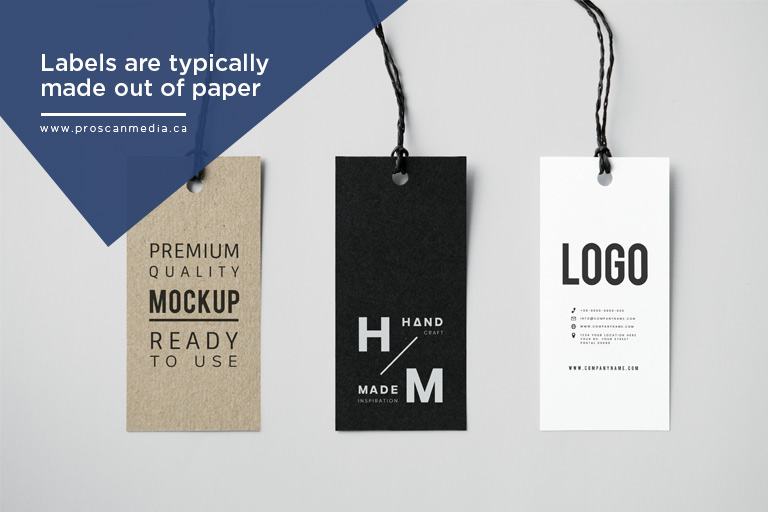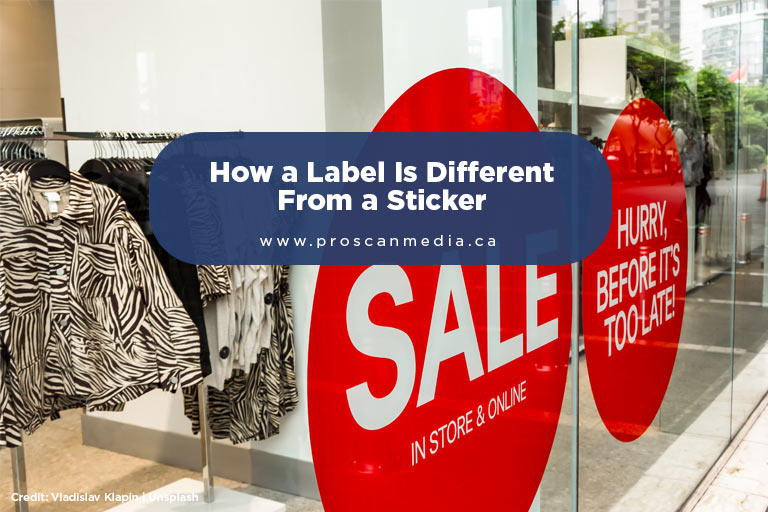Are you confused between a label and a sticker? Labels and stickers have many similarities, but there are also critical differences.
In this blog, you’ll learn the key distinctions between labels and stickers to help you decide which is best for your purpose. Let’s get started!
What Are Labels?

The term ‘label’ is used to refer to a variety of materials that are used for identification and decoration. Labels can often be confused with stickers, but there is a distinct difference between the two.
A label is typically made out of paper material and is usually attached to an object, such as a piece of clothing or an appliance, while a sticker is usually made out of plastic or vinyl material and can be affixed anywhere.
Labels are typically designed with a clear structure and have information printed directly onto them (permanent labels) or preprinted onto them (self-adhesive labels).
Labels are commonly used in businesses for product identification and branding purposes and for general branding purposes in any application. Labels provide important information such as product identifiers, usage instructions, warnings, and expiration dates that help customers decide what to purchase. Most labels will also include some kind of logo or artwork representing the brand name associated with the product.
Labels often display text with company contact information for customer service inquiries. Additionally, custom-printed labels can serve as proofs-of-purchase when needed for warranty purposes or customer contests.
What Are Stickers?
Stickers are popular for various uses, from adornment to decorative labelling. Under the umbrella term “sticker,” there are several categories, all of which are adhesive products: labels, decals, transfers, and tags.
Labels vs. Stickers

Differences in Uses
Labels and stickers both share information with consumers, whether it’s the brand of a product or ingredients and instructions. However, how they are used is different.
Labels are permanent adhesives designed to be placed on various surfaces for longer, such as bottles or packaging. Stickers can also contain important information, but they can also be used for promotional purposes.
Labelling displays information like ingredients, directions for use, warnings, and other relevant data related to the product. Stickers need not necessarily include this information — they can be used merely for branding and marketing.
On the other hand, labels must always provide the consumer with reliable information regarding a product or service because labelling plays a critical role in consumer safety and awareness.
Labels come in many varieties: paper labels like pressure-sensitive labels and thermal transfer labels; filmic labels like freezer filmic label stock; heavy-duty aluminum labels designed for harsh environments; plus barcode/RFID label solutions for product traceability.
On the other hand, stickers usually come in one type — pressure-sensitive adhesive sticker stock — and can range from small address/shipping labels to large vinyl decals used on windows or bumpers.
Differences in Materials
Labels are typically constructed of heavier materials compared to stickers. Stickers are made with paper or plastic material that often has an adhesive backing or a raised edge that produces a sealed bond after careful application.
On the other hand, labels are made of thicker material and can have adhesive applied directly to the label stock or applied through heat-activated rolling pressure.
Labels often have more durable construction and may be designed for outdoor use, making them an ideal choice when a well-adhered product is desired in harsh environments.
Labels also tend to have more printable space for longer messaging and may even contain raised text or embossed information in some cases. The thicker material can withstand tampering without destruction of the entire label — resulting in added security compared with stickers that come off whole when tampered with.
In addition, labels allow for easier readability with simple labelling solutions that are easily printed using inkjet or laser printers which can produce spot colour on demand rather than outsourcing large quantities of stickers from a production facility.
Differences in Production
The production process is key when talking about the difference between labels and stickers. Labels are printed on sheets of adhesive paper and then cut to size. On the other hand, stickers are mass-produced in large rolls so that users can customize their sizes for specific applications.
On the printing side, labels usually require more detailed graphics than stickers and additional features like variable data printing and stochastic screening; this makes them an ideal choice for short-run commercial printing. Stickers are often printed with line art or spot colour and can be printed quickly on either inkjet or flexographic web presses.
Constructing labels typically involves multiple layers of film laminated together for strength and durability; often, fluorescent or holographic films give them an extra wow factor.
In contrast, stickers generally only contain one layer applied directly to substrates such as paperboard or plastic films without requiring any lamination process.
Advantages of Labels
Labels have multiple advantages over stickers. They efficiently present your company’s branding and provide detailed product information, contact information, or instructions. Manufacturers and distributors commonly use labels for product tracking purposes or to indicate expiration dates.
Protective label coating can help them withstand harsh environmental conditions, moisture, grease, and abrasions. Gloss label paper reflects and enhances the colours of your artwork, while matte is designed to provide a velvety look that prevents finger smudging once applied.
Moreover, they don’t require additional lamination or special UV protection as some stickers need; they offer higher adhesion levels than stickers because they are made with pressure-sensitive adhesive by a machine capable of accurately controlling the amount applied.
Labels’ usefulness and durability make them cost-effective compared to their sticker counterparts. Finally, labels generally contain more information than their sticker counterpart, which helps simplify a successful marketing campaign by conveying all important details in one convenient package.
Advantages of Stickers
Stickers are a popular choice for labelling containers or packaging, and this option has a few benefits.
First, stickers offer maximum flexibility — you can customize the size, shape, and material to meet your specific needs. This gives you great flexibility when it comes to design and layout.
Secondly, labels designed to adhere permanently can be more cost-effective than traditional printed labels.
Thirdly, sticker labels offer durability and protection against tampering or abuse. They’re also easy to apply quickly, so production times can be decreased significantly.
Finally, custom sticker printing allows you to use any colour or image.
We Specialize in Stickers and Labels in Toronto
In conclusion, understanding the difference between a label and a sticker can be helpful when it comes to choosing the right type of adhesive for your needs. While both can convey important information or add visual appeal to a product, labels are typically more durable and long-lasting.
In contrast, stickers are more temporary and can be easily removed or repositioned. Whether you are looking for labels or sticker printing in Toronto, we can help. Contact us today at 1-877-488-3043 to learn more about our products.


